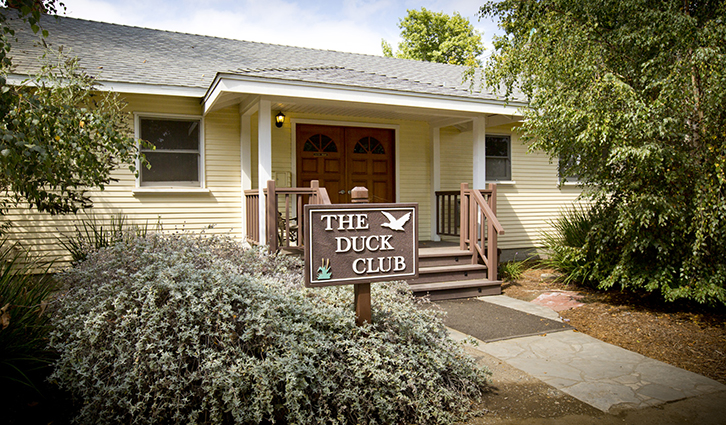Recycled Water
This is drought country. So how does Irvine Ranch Water District keep your home faucets flowing while also keeping the community so green and beautiful? In this video, real IRWD employees walk you through their innovative process – showing how they transform your used water into recycle water for landscape irrigation and other surprising uses.
Because Water Is Too Precious to Use Just Once ...
 At Irvine Ranch Water District, we meet about a quarter of our service area’s water demands with recycled water. Recycled water extends our drinking water supplies, reduces the need for additional drinking water facilities, reduces the amount of treated sewage discharged into the ocean, reduces our reliance on expensive imported water, and increases our water supply reliability. IRWD is a national leader in recycled water — with a history of achievements dating to 1963, when our Board of Directors implemented a vision to integrate water recycling into the design of our community. IRWD’s recycled water consistently meets the State Water Resources Control Board’s stringent water quality criteria for water reuse.
At Irvine Ranch Water District, we meet about a quarter of our service area’s water demands with recycled water. Recycled water extends our drinking water supplies, reduces the need for additional drinking water facilities, reduces the amount of treated sewage discharged into the ocean, reduces our reliance on expensive imported water, and increases our water supply reliability. IRWD is a national leader in recycled water — with a history of achievements dating to 1963, when our Board of Directors implemented a vision to integrate water recycling into the design of our community. IRWD’s recycled water consistently meets the State Water Resources Control Board’s stringent water quality criteria for water reuse.
History and video: IRWD's 50 years of recycled water
Download IRWD's Recycled Water Quality Report
What is recycled water?
Recycled water is the end product of sewage treatment that mirrors and accelerates the natural water cycle. Just as the earth takes moisture from the oceans and other sources and cycles it back to the headwaters, IRWD’s recycled water process removes contaminants and returns a clean resource. The treatment process takes about 16-18 hours from the time the sewage enters the treatment plant until the finished product is disinfected and ready for distribution throughout the service area.
Benefits of using recycled water
- Helps maintain long-term sustainability
- Increases water supply reliability
- Is a drought-proof source of water
- Reduces dependence on costly imported water
 Where does IRWD get recycled water?
Where does IRWD get recycled water?
Sewage from the local community is collected and treated to tertiary standards at the Michelson Water Recycling Plant in Irvine and the Los Alisos Water Recycling Plant in Lake Forest.
Click here to watch a video tour of the Michelson Water Recycling Plant.
How is IRWD recycled water used?
IRWD's recycled water is not for drinking or for other uses inside your home. But it is a key component of our water efficiency program, representing 28% of the District's total water supply. IRWD produces and distributes tertiary treated recycled water, also known as Title 22 water. Title 22 water is used throughout the IRWD service area primarily for landscape and agricultural irrigation. About 80% of the public and commercial irrigated landscape in our service area — including community association property, parks, medians, golf courses, and schools — is watered with recycled water. Recycled water is also treated for agricultural use, including edible root crops, where the water comes in contact with the edible portion of the crop. It also is used for toilet-flushing in dual-plumbed buildings, cooling towers in commercial buildings, dust control on construction sites and industrial processes such as concrete production and composting. Each day we deliver about 25 million gallons of recycled water to more than 6,000 metered customer connections. Every gallon of recycled water used for these purposes saves a gallon of drinking water.
Is recycled water regulated?
Yes. A large body of laws, regulations and statewide policies govern how recycled water is defined, what it can be used for, and under what conditions it can be used in California. Title 22 of the California Code of Regulations describes the treatment requirements for recycled water as well as the approved uses based on the level of treatment. Also included in Title 22 are the use area requirements, which describe restrictions on the use of recycled water and the requirement to notify the public by posting signs indicating a site uses recycled water. Title 17 of the California Code of Regulations describes the backflow devices required at a site when recycled water is being used, to maintain a clear separation between recycled water and drinking water. IRWD also extensively monitors, tests and reports on the recycled water we produce and distribute.
How is recycled water tested?
The IRWD Water Quality Department samples the recycled water system every week. While state regulations require IRWD to monitor the quality of recycled water as it leaves the recycling treatment plant, sampling within the distribution system is not required by any regulatory agency. IRWD provides that additional testing voluntarily, for the benefit of our customers and to maintain internal standards. Twelve distribution sites, three supplemental irrigation wells and four recycled-water storage reservoirs are tested on a monthly or more frequent basis.

How is recycled water distributed?
Recycled water is delivered through a distribution system that is completely separate from the drinking water infrastructure. This isolated system uses purple pipe to keep these valuable sources of water distinguishable and make the recycled water system easily identifiable. IRWD pioneered the use of purple piping, which is now the international symbol for recycled water. Click here for details on the official origin of the purple pipe.
Is residential use of recycled water allowed?
Recycled water is not available for use on individual properties unless they are estate-sized lots and the water is used exclusively for outside irrigation. If you think your property might be eligible, please contact the IRWD recycled water manager at 949-453-5592.

Where is recycled water stored?
Storage capacity is vital to a recycled water system. IRWD has 16 recycled water storage facilities. That includes four open-air seasonal-storage reservoirs — Rattlesnake, San Joaquin, Syphon and Sand Canyon (pictured above) — with a combined storage capacity of 1.6 billion gallons.
How is recycled water treated?
Recycled water is highly regulated by the state, and approved uses differ depending on the level of treatment applied. At IRWD, sewage undergoes primary, secondary and tertiary treatment at our two water recycling treatment plants.
• Primary treatment: This is the stage where large solids are removed.
• Secondary treatment: At this stage, bacteria are used to remove approximately 90% to 95% of the remaining solids.
• Tertiary treatment: IRWD uses two types of tertiary treatment.
- In traditional tertiary treatment, filtration removes any remaining solids. After filtration, this water is treated with a disinfectant, such as chlorine, to destroy bacteria, viruses and other pathogens.
- A more refined tertiary treatment process uses a combination of membrane bioreactor filtration and ultraviolet light disinfection. This new technology produces a more purified water and reduces the need for traditional disinfection chemicals like chlorine.
• Advanced tertiary treatment: This process uses filtration or reverse osmosis to duplicate and accelerate nature’s own purifying system. This advanced treatment produces recycled water so pure that it can be used for groundwater recharge, where it ultimately works its way back into the drinking water cycle. Locally, the Orange County Water District is producing and using advanced treated recycled water from its Groundwater Replenishment System to supplement water supplies in the Orange County Groundwater Basin.

[Click image to enlarge]
The History of Recycled Water in Agriculture
Recycled water has been used in agriculture for more than 100 years, and agricultural irrigation is the single largest use for recycled water in the state, according to a 2015 survey of California water recycling agencies. At the time of the survey, more than 30% of recycled water used in California was for agricultural irrigation.
IRWD produces disinfected tertiary recycled water which, according to Section 60304 of Title 22, can be used to irrigate food crops, including all edible root crops, where recycled water comes into contact with the edible portion of the crop. The District has been serving recycled water to agricultural sites in its service area for decades.
Recycled Water Policy Paper
IRWD is a leader in recycled water development and use. The District currently meets almost a quarter of our total water demands with recycled water through irrigation, agriculture, toilet flushing, cooling towers, and industrial processes. Recycled water is a key component of IRWD's conservation and water use efficiency programs because every gallon of recycled water used results in a gallon of drinking water that can be saved for potable uses increasing local supply reliability and resulting in less importation from the Delta or the Colorado River. Despite the enormous success IRWD has achieved with recycled water, there is still more we hope to do with our recycled water resources.
IRWD supports the expanded use of recycled water because it is an important component of California's sustainable water future and economic strength. However, the current regulatory and permitting framework for recycled water, established more than 20 years ago, is an obstacle to developing cost-effective recycling projects. IRWD advocates for state and federal policies which reflect the current scientific understanding of the benefits of recycled water and the appropriate limits to its use.
For more information on the Recycled Water Use Economic Incentives policy principles adopted by the IRWD Board of Directors
Indoor Recycled Water Use
AB 1406 (Huffman), successfully sponsored by IRWD in 2007, changed the California Water Code to allow recycled water to be used for indoor uses such as toilet flushing and cooling towers in multi-level condominium complexes.
California Plumbing Code
SB 283 (DeSaulnier), successfully sponsored by IRWD in 2009, paved the way for the adoption of California Plumbing Code provisions setting forth design standards for the safe plumbing of approved buildings with both potable and recycled water systems allowing.
Water Softeners
AB 1366 (Feuer/Caballero/A. Strickland) was successfully sponsored by a coalition of water agencies including IRWD in 2009. The bill provided water agencies in specified areas of the state with a critical tool for managing controllable salts discharged by self-regenerating water softeners.
Water Recycling Act
In partnership with the California WateReuse Association, San Diego County Water Authority, Eastern Municipal Water District, West Basin Municipal Water District, and El Dorado Irrigation District, IRWD co-sponsored AB 2398 (Hueso), which would have enact the Water Recycling Act of 2012. In 2013, IRWD actively supported AB 803 (Gomez) sponsored by the California WateReuse Association. These bills sought to expand the use of recycled water in California by improving and streamlining the existing regulatory and permitting process for recycled water projects to reflect current scientific study and advances in treatment technology.

Recycled Water Customer, Agency and Technical Information
Mark Tettemer
Manager of Recycled Water
949-453-5592
tettemer@IRWD.com

General Inquiries, Students, and Media Contact Information
Customer Service
949-453-5300
(Check out the library for current copies of IRWD's Rules and Regulations,Procedural Guidelines - section 5, Recycled Water Checklist, Sign Specifications)




 Where does IRWD get recycled water?
Where does IRWD get recycled water?









